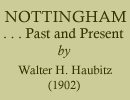
NOTTINGHAM CASTLE.
NOTTINGHAM CASTLE has long stood as one of the famous landmarks of the country. The earliest mention by historians is of the period of conflict between the Anglo-Saxons and Danes, and it is on record that in 922 Edward garrisoned the Castle with English and Danish soldiers, the latter being expelled in 941, only to return later to be eventually massacred. In 1642 Charles I. planted the Royal Standard on a tower in the Castle, but, being blown down, it was planted on where is now known as "Standard Hill." Colonel Hutchinson obtained an order to demolish the Castle, but Cromwell was wrath at finding it dismantled on his visit in 1650.
In 1674 it was purchased by the first Duke of Newcastle from the Duke of Rutland, who then held the rights, and thoroughly renovated and almost entirely rebuilt at a cost of over £14,000, being completed in 1679. During the reign of James II. Princess Anne of Denmark resided there.
In 1832 a Nottingham mob, infuriated by the rejection of the Reform Bill by the House of Lords, demolished the stately structure and left it a blackened ruin.
Our illustration shews the Castle before its restoration, which did not take place until 1875, cost upwards of £20,000, and was inaugurated as an Art Museum in 1878, by the present King and Queen, (then Prince and Princess of Wales.)
